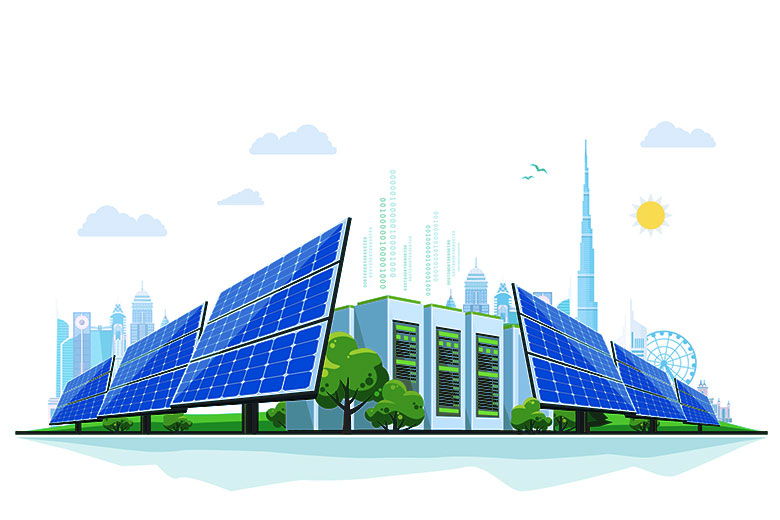Powering India’s Data Center Boom Through Low-Cost, Low-Carbon Energy Solutions
Nithya Balakrishnan
August 2021

INDIA’s DATA CENTER BOOM
Delhi, Mumbai, Bengaluru and Chennai – what do these cities have in common? They are home to over 60% of India’s Datacenters, with Hyderabad and Pune slowly playing catch up. Corporates like AWS, Google, PDG, STT, CtrlS, Adani Enterprises, Ascendas, Digital Realty & Brookfield Infrastructure are betting big on the government’s upcoming DC policy and lining up huge investment into this market. Increased reliance on localization of servers to protect privacy, IoT-based apps & services, digital technology, remote working, 5G telephony, data consumption and analytics are key drivers of this boom in the subcontinent.
A recent report by research firm CRISIL has indicated that the industry requirement of 6 million sq ft of development will require an investment of nearly $3.7 billion by 2024-25. India, which currently accounts for merely 1-2% of the global market share for DCs is touted to reach $4.5 billion by 2025 and has been growing annually at 25-30% since 2016.
There are two sides to an ongoing debate – whether you believe that for India, ‘Data is the new Oil’ or ‘Sunlight is the new Oil’, one thing is evident. The exponential growth of the former is bound to result in an increased demand for the latter.
THE GOVERNMENT’s POLICY PUSH FOR DCs
The Ministry of Electronics and IT is working on a standalone Datacenter policy to help establish India as a leading global hub for the same. Incentives like easier access to land and financing, reduction in cross-subsidies, availability of low-cost, clean energy and a single-window mechanism for approvals to DC operators are on the anvil. The government is also mulling ‘infrastructure’ status to the sector to promote easier, low-cost credit access across the domestic and international arena. These are all steps in the right direction as they will pave the way for not just enterprise DCs but hyperscale centers to be established across metros, tier-1 and tier-2 cities.
ENERGY CONSUMPTION ACROSS DATA CENTERS
Servers, storage devices, cooling infrastructure and network drives – almost all components of DCs require access to continuous, uninterrupted, stable and affordable electricity. As the industry stands on the cusp of exponential growth in India, it becomes imperative to acknowledge the potential climate risk posed by this increase in energy demand and its related emissions. For a price-sensitive, developing geography like ours – it is mandatory for DCs to emulate global best practices and switch to renewable, low-carbon sources of power. This will also hugely benefit the industry in revenue terms, as electricity bills can constitute up to 70% of the operational costs for DCs.
Meanwhile, increasing energy efficiencies across DCs is already in play – better cooling systems, insulation, ambient temperature settings, proper ventilation, syncing of server capacity and load are ways the industry is prioritizing the same.
INDIA’s PROJECTED ENERGY DEMAND
According to a 2021 report released by the IEA – India is all set to outrank the European Union as the 3rd largest consumer of electricity globally by 2030; and over the next two decades the country’s demand for energy is expected to surpass all others. The government’s drive towards local manufacturing, digitalization, urbanization, industrialization and jobs creation has contributed to this growth forecast.
This undoubtedly puts India in the centerstage of global energy policy – our measures to reduce import dependency on oil, natural gas and coking coal as well as reducing reliance on coal-fired electricity will determine our success towards decarbonization. Being home to 9 out 10 most polluted cities in the world leaves us with no choice but to accelerate both the commercial and residential adoption of renewable, low-carbon energy sources. All new power to be connected to the grid, must be clean energy.
This makes the case even stronger for India’s Datacenters to emulate their global peers and adopt sustainable practices at the earliest.
DATA CENTERS & SUSTAINBLE ENERGY – KEY EMERGING TRENDS
Virtual Power Purchase Agreements (VPPAs), Renewable Energy Certificates (RECs), Wind-Solar hybrid, pure play BIPV, storage, onsite and offsite solar via the open access route – these are just some of the models adopted by global industry players to go green and offset carbon emissions.
Amazon, Google, Facebook, Microsoft, Iron Mountain and Princeton Digital are some of the key global leaders who have committed to procuring renewable energy to power their facilities and thereby rein in their carbon emissions.
In India, this phenomenon is yet to gain significant momentum, but a start has been made by players like RackBank, NTT, Nxtra, CTRLS and STT GDC to switch to procurement of clean energy to power their facilities.
HOW CAN SOLAR POWER BENEFIT DATA CENTERS IN INDIA?
Green data centers will be the future of the industry – most players are already looking to develop captive solar, wind and hybrid plants to power their DCs or rely on solar via open access to meet at least 80% of their energy requirement through RE sources. The value proposition of cost-savings for solar continues to be a big driver, as does the resultant environmental benefits.
Innovative financing models, assured return on investment, easy integration with the grid, long-term clarity on energy costs and hassle-free operations and maintenance of RE plants are other benefits that DCs are keen on leveraging.
India’s Data Center revolution is truly underway – and the industry looks poised to utilize this opportunity of exponential growth to accelerate energy transition. Enabling policy and easy adoption will pave the way for the sector to influence the rest of India Inc. to follow suit on committing to Decarbonisation.